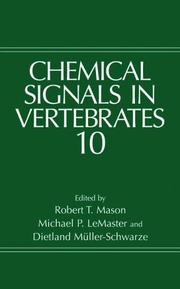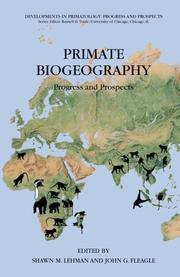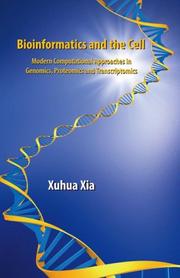| Listing 1 - 10 of 142 | << page >> |
Sort by
|
Book
ISBN: 3319916890 3319916882 Year: 2018 Publisher: Cham Springer Nature
Abstract | Keywords | Export | Availability | Bookmark
 Loading...
Loading...Choose an application
- Reference Manager
- EndNote
- RefWorks (Direct export to RefWorks)
The average person can name more bird species than they think, but do we really know what a bird “species” is? This open access book takes up several fascinating aspects of bird life to elucidate this basic concept in biology. From genetic and physiological basics to the phenomena of bird song and bird migration, it analyzes various interactions of birds – with their environment and other birds. Lastly, it shows imminent threats to birds in the Anthropocene, the era of global human impact. Although it seemed to be easy to define bird species, the advent of modern methods has challenged species definition and led to a multidisciplinary approach to classifying birds. One outstanding new toolbox comes with the more and more reasonably priced acquisition of whole-genome sequences that allow causative analyses of how bird species diversify. Speciation has reached a final stage when daughter species are reproductively isolated, but this stage is not easily detectable from the phenotype we observe. Culturally transmitted traits such as bird song seem to speed up speciation processes, while another behavioral trait, migration, helps birds to find food resources, and also coincides with higher chances of reaching new, inhabitable areas. In general, distribution is a major key to understanding speciation in birds. Examples of ecological speciation can be found in birds, and the constant interaction of birds with their biotic environment also contributes to evolutionary changes. In the Anthropocene, birds are confronted with rapid changes that are highly threatening for some species. Climate change forces birds to move their ranges, but may also disrupt well-established interactions between climate, vegetation, and food sources. This book brings together various disciplines involved in observing bird species come into existence, modify, and vanish. It is a rich resource for bird enthusiasts who want to understand various processes at the cutting edge of current research in more detail. At the same time it offers students the opportunity to see primarily unconnected, but booming big-data approaches such as genomics and biogeography meet in a topic of broad interest. Lastly, the book enables conservationists to better understand the uncertainties surrounding “species” as entities of protection.
Zoology. --- Animal ecology. --- Evolution (Biology). --- Animal Ecology. --- Evolutionary Biology. --- Animal evolution --- Animals --- Biological evolution --- Darwinism --- Evolutionary biology --- Evolutionary science --- Origin of species --- Biology --- Evolution --- Biological fitness --- Homoplasy --- Natural selection --- Phylogeny --- Zoology --- Ecology --- Natural history --- Evolutionary biology. --- Life sciences --- Animal ecology

ISBN: 1280656794 9786610656790 038725160X 0387251596 1441937765 Year: 2005 Publisher: New York : Springer,
Abstract | Keywords | Export | Availability | Bookmark
 Loading...
Loading...Choose an application
- Reference Manager
- EndNote
- RefWorks (Direct export to RefWorks)
The editors and contributors to this volume should be justifiably proud of their participation in the tenth triennial meeting of the Chemical Signals in Vertebrates International Symposium. This meeting was held 27 years after the initial gathering of participants in Saratoga Springs, New York from June 6* to 9*, 1976. Subsequent meetings have been held every three years in Syracuse, New York; Sarasota, Florida; Laramie, Wyoming; Oxford, England; Philadelphia, Pennsylvania; Tubingen, Germany; Ithaca, New York; and Krakow, Poland. This tenth aimiversary symposium was held from July 29* through August 1*' in Corvallis, Oregon and was hosted by the Zoology Department and Biology Programs of Oregon State University. This book also represents the tenth in a series of books on chemical communication, chemical ecology, olfactory and vomeronasal research in vertebrate species. The species covered in the chapters herein range from fish to mammals including humans. By taxonomic breakdown the mammals are the most represented in number of species and chapter contributions. However, the hosts of the meeting endeavored to have some representative contributions covering all of the major vertebrate taxa. As in past years, the meeting was well-represented with just over 100 participants from 13 different nations. Plenary talks focused on some of the non-mammalian groups that have tended to be less represented in these symposia. Thus, we had a very nice overview of comparisons and contrasts of invertebrate chemical commimication to vertebrate systems.
Chemical senses --- Vertebrates --- Physiology --- Ecology. --- Evolution (Biology). --- Vertebrates. --- Zoology. --- Evolutionary Biology. --- Biology --- Natural history --- Animals --- Vertebrata --- Chordata --- Animal evolution --- Biological evolution --- Darwinism --- Evolutionary biology --- Evolutionary science --- Origin of species --- Evolution --- Biological fitness --- Homoplasy --- Natural selection --- Phylogeny --- Balance of nature --- Bionomics --- Ecological processes --- Ecological science --- Ecological sciences --- Environment --- Environmental biology --- Oecology --- Environmental sciences --- Population biology --- Ecology --- Ecology . --- Evolutionary biology.
Book
ISBN: 1280937416 9786610937417 3540692762 3540692754 3642088767 Year: 2007 Publisher: Berlin ; London : Springer,
Abstract | Keywords | Export | Availability | Bookmark
 Loading...
Loading...Choose an application
- Reference Manager
- EndNote
- RefWorks (Direct export to RefWorks)
Across the globe, about 250 species of rodents spend most of their lives in safe and stable, but dark, oxygen-poor and carbon dioxide-rich burrows, deprived of most of the sensory cues available aboveground. They have become fully specialized for a unique way of life in which foraging and breeding take place underground. The systematic research into adaptations of subterranean dwellers is only about two decades old, but it has rapidly intensified within the last few years, bringing insight into many aspects of the biology and evolution at different organization levels. Subterranean Rodents presents achievements from the last years of research on these rodents, divided into five sections: ecophysiology; sensory ecology; life histories, behavioural ecology and demography; environmental and economical impact; molecular ecology and evolution. It is a must for all researchers working in this field and will be of interest to zoologists, physiologists, morphologists, ecologists, and evolutionary biologists.
Rodents. --- Burrowing animals. --- Rodents --- Adaptation. --- Animals --- Animal burrowing --- Rodentia --- Mammals --- Zoology. --- Animal physiology. --- Animal ecology. --- Evolution (Biology). --- Vertebrates. --- Animal Physiology. --- Animal Ecology. --- Evolutionary Biology. --- Animal evolution --- Biological evolution --- Darwinism --- Evolutionary biology --- Evolutionary science --- Origin of species --- Biology --- Evolution --- Biological fitness --- Homoplasy --- Natural selection --- Phylogeny --- Vertebrata --- Chordata --- Zoology --- Ecology --- Animal physiology --- Anatomy --- Natural history --- Physiology --- Evolutionary biology.
Book
ISBN: 1281276006 9786611276003 1402082746 1402082738 9048178282 Year: 2008 Publisher: New York : Springer,
Abstract | Keywords | Export | Availability | Bookmark
 Loading...
Loading...Choose an application
- Reference Manager
- EndNote
- RefWorks (Direct export to RefWorks)
Much of our knowledge of stem cells has been inferred from studies of remarkable few species. The ability to manipulate stem cells in “model” organisms such as the mouse and a few other vertebrate species has driven our understanding of basic biology of stem cells. The power and efficiency of studying model organisms, however, comes at a cost since a few species, obviously, do not reflect nature´s true diversity. Unfortunately, although all multicellular organisms seem to rely on stem cells, and although this seems to be a question of key importance for understanding the evolution of animal life, little is known about stem cells in early-branching taxa. “Stem Cells: From Hydra to Man” illustrates that there is more than human and mouse stem cells to learn from. Reflecting an enormous growth in the knowledge of stem cells in various organisms, the book presents the conceptual language and the nature of questions, as well as a summary of the advances in our understanding of stem cells from a comparative point of view that has resulted from the development of new technology and the development of novel model organisms over the past few decades. As such this book is largely a horizon analysis of a frontier rather than a retrospective. It presents an integrative approach to animal stem cells and covers the major contributions, tools and trends in a newly emerging field: comparative stem cell biology.
Stem cells. --- Physiology, Comparative. --- Comparative physiology --- Medicine, Comparative --- Zoology --- Colony-forming units (Cells) --- Mother cells --- Progenitor cells --- Cells --- Cytology. --- Developmental biology. --- Evolution (Biology). --- Cell Biology. --- Developmental Biology. --- Evolutionary Biology. --- Animal evolution --- Animals --- Biological evolution --- Darwinism --- Evolutionary biology --- Evolutionary science --- Origin of species --- Biology --- Evolution --- Biological fitness --- Homoplasy --- Natural selection --- Phylogeny --- Development (Biology) --- Growth --- Ontogeny --- Cell biology --- Cellular biology --- Cytologists --- Cell biology. --- Evolutionary biology.
Book
ISBN: 1281552372 9786611552374 3540789936 3540789928 3642097812 Year: 2008 Publisher: Berlin : Springer,
Abstract | Keywords | Export | Availability | Bookmark
 Loading...
Loading...Choose an application
- Reference Manager
- EndNote
- RefWorks (Direct export to RefWorks)
Every biological system is the outcome of its evolution; therefore, the deciphering of its evolutionary history is of tremendous importance to understand the biology of a system. Since 1997 scientists of different disciplines have held an annual "Evolutionary Biology Meeting" at Marseille (France) in order to discuss their research developments, exchange ideas and start collaborations. Consisting of the most representative talks of the 11th meeting, this book provides an up-to-date overview of evolutionary concepts and how these concepts can be applied to a better understanding of various biological aspects. It is divided into the following four parts: Modelization of Evolution - Concepts in Evolutionary Biology - Knowledge - Applied Evolutionary Biology. This book is an invaluable source of information not only for evolutionary biologists, but also for biologists in general.
Evolution (Biology) --- Evolution (Biology). --- Developmental biology. --- Bioinformatics. --- Animal genetics. --- Evolutionary Biology. --- Developmental Biology. --- Animal Genetics and Genomics. --- Genetics --- Bio-informatics --- Biological informatics --- Biology --- Information science --- Computational biology --- Systems biology --- Development (Biology) --- Growth --- Ontogeny --- Animal evolution --- Animals --- Biological evolution --- Darwinism --- Evolutionary biology --- Evolutionary science --- Origin of species --- Evolution --- Biological fitness --- Homoplasy --- Natural selection --- Phylogeny --- Data processing --- Evolutionary biology. --- Marseille <2007>
Book
ISBN: 1281757462 9786611757465 4431785418 443178540X 4431998500 Year: 2008 Publisher: [Tokyo] : Springer,
Abstract | Keywords | Export | Availability | Bookmark
 Loading...
Loading...Choose an application
- Reference Manager
- EndNote
- RefWorks (Direct export to RefWorks)
Bacteria change the surface of the Earth. All kinds of bacteria reside in the biosphere, and although sometimes they may cause damage, they also help in cleaning the surface of the Earth and in the circulation of various substances. Chemolithoautotrophic bacteria in particular have a unique and intimate relationship with inorganic substances and human beings. This book covers in detail advances in the biochemistry and physiology of several chemolithoautotrophic bacteria as well as their relationship to certain environments. Included are recent findings regarding the oxidation mechanisms of ammonia, nitrite, sulfur compounds, and ferrous iron by special bacteria. The characteristics of many cytochromes are described to further advance the understanding of bacterial oxidation systems of inorganic compounds. Applications of bacteria, such as in sewage treatment and in biohydometallurgy, among others, are detailed, and bacteria considered closest to the origins of life are discussed in the final chapter.
Chemoautotrophic bacteria. --- Bacteriology. --- Biochemistry. --- Evolution (Biology) --- Biological chemistry --- Chemical composition of organisms --- Organisms --- Physiological chemistry --- Biology --- Chemistry --- Medical sciences --- Microbiology --- Composition --- Animal evolution --- Animals --- Biological evolution --- Darwinism --- Evolutionary biology --- Evolutionary science --- Origin of species --- Evolution --- Biological fitness --- Homoplasy --- Natural selection --- Phylogeny --- Bacteria, Chemoautotrophic --- Autotrophic bacteria --- Microbiology. --- Microbial ecology. --- Evolution (Biology). --- Microbial Ecology. --- Evolutionary Biology. --- Biochemistry, general. --- Environmental microbiology --- Microorganisms --- Ecology --- Microbial biology --- Evolutionary biology.

ISBN: 1281066389 9786611066383 354071779X 3540717773 3540717781 Year: 2007 Publisher: Berlin ; New York : Springer,
Abstract | Keywords | Export | Availability | Bookmark
 Loading...
Loading...Choose an application
- Reference Manager
- EndNote
- RefWorks (Direct export to RefWorks)
This book is the first detailed biography of Ernst Mayr. He was an ‘architect’ of the Synthetic Theory of Evolution, and the greatest evolutionary biologist since Charles Darwin, influential historian and philosopher of biology, outstanding taxonomist and ornithologist, and naturalist. He is one of the most widely known biologists of the 20th century. Mayr used the theories of natural selection and population thinking as theoretical models within the framework of historical biological studies. He suggested that various competing paradigms may exist side by side and more or less pronounced ’revolutions’ may occur in different fields from time to time. Changes of concepts have a much stronger effect on the development of biological sciences than the discovery of new facts. Mayr was the first to emphasize the role of biopopulations, thereby pointing out the basic difference between ’population thinking’ and typological essentialism. Population thinking takes into consideration the uniqueness of each individual and unlimited variation of populations which may lead to the development of new species. On the other hand, typologists assume that the unchanging essence of each species determines variation and fixed limits of variation preclude speciation from occurring except through saltation. Jürgen Haffer majored in geology and paleontology obtaining a PhD degree at the University of Göttingen. He became an exploration geologist and lived in South and North America, Iran, Egypt, and Norway. During these assignments he studied the bird faunas of Amazonia and Iran and has been in close communication with Ernst Mayr. He also co-published a biography of Erwin Stresemann, Mayr’s teacher and friend in Berlin, Germany.
Naturalists --- Ornithologists --- Mayr, Ernst, --- Scientists --- Zoologists --- Maĭr, Ė., --- Evolution (Biology). --- Life sciences. --- Zoology. --- Animal ecology. --- History. --- Evolutionary Biology. --- Life Sciences, general. --- Animal Ecology. --- History of Science. --- Animals --- Zoology --- Ecology --- Biology --- Natural history --- Biosciences --- Sciences, Life --- Science --- Animal evolution --- Biological evolution --- Darwinism --- Evolutionary biology --- Evolutionary science --- Origin of species --- Evolution --- Biological fitness --- Homoplasy --- Natural selection --- Phylogeny --- Annals --- Auxiliary sciences of history --- Evolutionary biology.
Book
ISBN: 9811049564 9811049556 Year: 2017 Publisher: Cham Springer Nature
Abstract | Keywords | Export | Availability | Bookmark
 Loading...
Loading...Choose an application
- Reference Manager
- EndNote
- RefWorks (Direct export to RefWorks)
This book facilitates an integrative understanding of the development, genetics and evolution of butterfly wing patterns. To develop a deep and realistic understanding of the diversity and evolution of butterfly wing patterns, it is essential and necessary to approach the problem from various kinds of key research fields such as “evo-devo,” “eco-devo,” ”developmental genetics,” “ecology and adaptation,” “food plants,” and “theoretical modeling.” The past decade-and-a-half has seen a veritable revolution in our understanding of the development, genetics and evolution of butterfly wing patterns. In addition, studies of how environmental and climatic factors affect the expression of color patterns has led to increasingly deeper understanding of the pervasiveness and underlying mechanisms of phenotypic plasticity. In recognition of the great progress in research on the biology, an international meeting titled “Integrative Approach to Understanding the Diversity of Butterfly Wing Patterns (IABP-2016)” was held at Chubu University, Japan in August 2016. This book consists of selected contributions from the meeting. Authors include main active researchers of new findings of corresponding genes as well as world leaders in both experimental and theoretical approaches to wing color patterns. The book provides excellent case studies for graduate and undergraduate classes in evolution, genetics/genomics, developmental biology, ecology, biochemistry, and also theoretical biology, opening the door to a new era in the integrative approach to the analysis of biological problems. This book is open access under a CC BY 4.0 license. .
Life sciences. --- Developmental biology. --- Evolutionary biology. --- Animal genetics. --- Entomology. --- Biomathematics. --- Life Sciences. --- Animal Genetics and Genomics. --- Evolutionary Biology. --- Mathematical and Computational Biology. --- Developmental Biology. --- Development (Biology) --- Biology --- Growth --- Ontogeny --- Biosciences --- Sciences, Life --- Science --- Mathematics --- Insects --- Zoology --- Genetics --- Animal evolution --- Animals --- Biological evolution --- Darwinism --- Evolutionary biology --- Evolutionary science --- Origin of species --- Evolution --- Biological fitness --- Homoplasy --- Natural selection --- Phylogeny --- Evolution (Biology). --- nymphalid --- ecology --- evolution --- genetics --- mimicry

ISBN: 0387317104 0387298711 1441940081 Year: 2006 Publisher: New York, NY : Springer US : Imprint: Springer,
Abstract | Keywords | Export | Availability | Bookmark
 Loading...
Loading...Choose an application
- Reference Manager
- EndNote
- RefWorks (Direct export to RefWorks)
Biogeography, the study of the distribution of organisms over the surface of the earth, plays a central role in our understanding of virtually all aspects of the biology of primates and other animals, including systematics, mechanisms of speciation, population genetics and demography. The distribution of primates relative to aspects of climate and habitat, including altitude, forest type, and food availability, forms the basis for our understanding of ecological and behavioral adaptations. The biogeography of primates in the past is a major component of our understanding of their evolutionary history and is an essential component of conservation biology. This volume, which brings together these papers on the biogeography of primates, past and present, provides an introduction to Primate Biogeography as a discipline, illustrates the many factors that may influence the distribution of primates, and demonstrates the wide range of methodological approaches that are available to understanding the distribution of this order.
Primates --- Geographical distribution. --- Quadrumana --- Mammals --- Zoology. --- Evolution (Biology). --- Paleontology . --- Geology. --- Ecology. --- Evolutionary Biology. --- Paleontology. --- Historical Geology. --- Balance of nature --- Biology --- Bionomics --- Ecological processes --- Ecological science --- Ecological sciences --- Environment --- Environmental biology --- Oecology --- Environmental sciences --- Population biology --- Geognosy --- Geoscience --- Earth sciences --- Natural history --- Fossilogy --- Fossilology --- Palaeontology --- Paleontology, Zoological --- Paleozoology --- Historical geology --- Zoology --- Fossils --- Prehistoric animals in motion pictures --- Animal evolution --- Animals --- Biological evolution --- Darwinism --- Evolutionary biology --- Evolutionary science --- Origin of species --- Evolution --- Biological fitness --- Homoplasy --- Natural selection --- Phylogeny --- Ecology --- Evolutionary biology. --- Historical geology. --- Ecology . --- Geology

ISBN: 1280852585 9786610852581 0387713379 0387713360 1441943919 Year: 2007 Publisher: New York : Springer,
Abstract | Keywords | Export | Availability | Bookmark
 Loading...
Loading...Choose an application
- Reference Manager
- EndNote
- RefWorks (Direct export to RefWorks)
"Xuhua Xia’s Bioinformatics and the Cell is a welcome addition to the bourgeoning field of bioinformatics text books. Xia stakes out a too-often neglected middle ground in bioinformatics by presenting a work that emphasizes methods’ biological utility without eschewing algorithmic formalism. Readers will find a well-rounded presentation of bioinformatics techniques employed in genomics, transcriptomics and proteomics – unified throughout by the common theme of molecular evolution." - I. King Jordan, School of Biology, Georgia Institute of Technology "Bioinformatics and the Cell is a remarkable book because it integrates the more technical and mathematical aspects of bioinformatics with concrete examples of their application to current research problems in molecular and cellular biology. I believe that this broad, unified approach is made possible, in large part, by the very wide scope of Dr. Xia’s own research experience. The integration of genomics, proteomics and transcriptomics into a single volume makes this book required reading for students entering the new and emerging field of Systems Biology. This is truly a path breaking book." - Donal Hickey, Concordia University, Montreal, Quebec, Canada Bioinformatics and the Cell is the first book with comprehensive numerical illustration of mathematical techniques and computational algorithms used in bioinformatics to convert the rapidly increasing molecular data into organized biological knowledge, with a focus on interactions among DNA, RNA and proteins in the cell. A sample of the illustrated algorithms includes: String matching algorithms with associated statistics Sequence alignment with the affine function and profile alignment for multiple sequence alignment Contig assembly algorithms Perceptrons Hidden Markov models Gibbs sampler Self-organizing map Algorithms in molecular phylogenetics EM algorithm for maximum likelihood calculation Monte Carlo integration and Markov chain Monte Carlo algorithms for Bayesian inference Mass deconvolution and computational methods for peptide mass fingerprinting By rendering both mathematics and biology to numbers, this book should appeal not only to biologists, but also to mathematicians, biostatisticians, and computational scientists, especially those younger ones with an ambition to conquer the rough terrain of bioinformatics. Dr. Xuhua Xia obtained his PhD in population biology at University of Western Ontario in 1990 and made his entry into molecular evolution and phylogenetics at University of Washington in 1993. He was recruited by University of Hong Kong in 1996 as an assistant professor, and served as a senior scientist and the founding head of the Bioinformatics Laboratory of HKU-Pasteur Research Centre. Dr. Xia joined University of Ottawa in 2002 where he is cross-appointed to both Biology Department and the School of Information Technology Engineering. He is an active member in the Center for Advanced Research in Environmental Genomics and the Ottawa Institute of Systems Biology. His web site is at http://dambe.bio.uottawa.ca.
Bioinformatics. --- Genomics --- Proteomics --- Data processing. --- Bio-informatics --- Biological informatics --- Biology --- Information science --- Computational biology --- Systems biology --- Data processing --- Molecular biology --- Proteins --- Genome research --- Genomes --- Molecular genetics --- Research --- Biochemistry. --- Proteomics. --- Cytology. --- Evolution (Biology). --- Biochemistry, general. --- Cell Biology. --- Evolutionary Biology. --- Animal evolution --- Animals --- Biological evolution --- Darwinism --- Evolutionary biology --- Evolutionary science --- Origin of species --- Evolution --- Biological fitness --- Homoplasy --- Natural selection --- Phylogeny --- Cell biology --- Cellular biology --- Cells --- Cytologists --- Biological chemistry --- Chemical composition of organisms --- Organisms --- Physiological chemistry --- Chemistry --- Medical sciences --- Composition --- Cell biology. --- Evolutionary biology.
| Listing 1 - 10 of 142 | << page >> |
Sort by
|

 Search
Search Feedback
Feedback About UniCat
About UniCat  Help
Help News
News